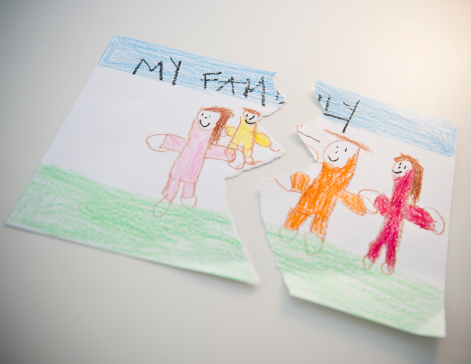 On lists of life stressors, divorce is usually ranked among the top two or three most emotionally challenging events. The process itself is experienced as highly stressful by many people, and from what we know about recovery from profound loss, it takes at least a year to begin to regain equilibrium. In other words, the stress caused by a divorce does not usually just go away when the decree is signed. Especially in situations in which there has been a high level of tension and acrimony during the divorce process, it can be very difficult to shift from conflict mode to co-parenting mode if there are children in the family.
On lists of life stressors, divorce is usually ranked among the top two or three most emotionally challenging events. The process itself is experienced as highly stressful by many people, and from what we know about recovery from profound loss, it takes at least a year to begin to regain equilibrium. In other words, the stress caused by a divorce does not usually just go away when the decree is signed. Especially in situations in which there has been a high level of tension and acrimony during the divorce process, it can be very difficult to shift from conflict mode to co-parenting mode if there are children in the family.
New sources of stress can arise post-decree, e.g. introducing children to new significant others, a parent’s decision to move, loss of a job, children struggling to adapt to the new normal. It is normal for these kinds of change to create uncertainty and distress.
When contemplating a divorce, many people turn to divorce professionals for ideas, advocacy and support. This can lessen feelings of isolation and uncertainty during a time of crisis. However, after the decree has been submitted to the court, people may feel they are on their own to pick themselves up and commence with the rest of their lives.
It has been my experience that specific post-decree support provided by neutral coaches and neutral child specialists can be an invaluable resource for families defining their new normal after a divorce. In the context of voluntary post decree alternative dispute resolution, resources can be shared, support given, and skills developed for effective co-parenting. Parenting and relationship plans can be created (if not completed during the divorce itself) or revised by joint agreement. In the context of voluntary alternative dispute resolution, children can be safely included in this process, e.g. to check in about their adjustment to new schedules and routines. It has been suggested that follow up care like this should be offered to all divorcing couples, though not all may need it.
This is not a replacement for psychotherapy. Individual therapy can enhance personal growth, provide support and help adults and children heal emotionally. Couples therapy specific to the end of marriage can help resolve lingering emotional issues and conflict. Family therapy may be valuable, especially if relationship repair between parents and children is needed. It is also not a replacement for support groups or resources like Daisy Camp. However, post-decree consultation with neutral experts who specialize in helping family members make the healthiest possible adjustment to a divorce can be a focused and powerful kind of support during a challenging time of transition.



 It’s Friday night and your children are with your ex for the night. It should be a nice quiet, relaxing evening, or maybe a great time to tackle that organization project? Possibly even a date night?! Instead, you’ve already burnt your own dinner because your ex has called you 14 times
already with mindless questions about the kids. “Blake doesn’t want to eat chicken nuggets, what do I do? Can you just talk to him for a minute and see if you can talk him into eating?” “Kara had a potty training accident, what do I do? Can you bring over more clothes?” “Cole refuses to do his homework, what do I do?” Your quiet night alone has turned into YOU still doing the
bulk of the parenting, when you just want to scream, “You’re their parent too!” to your ex. How can you set up boundaries to avoid arguments and
resentment regarding your parenting time while away from the kids?
Let’s face it, it’s not that you don’t love being a parent to your children.
It’s just that you went through this divorce that (maybe) you didn’t
necessarily want, then (maybe) you had to argue a bit over custody, and now
that everything is settling you are trying to make lemonade from your lemons
and actually enjoy your “free time.” You might also start to wonder whether
all those calls are because your spouse is being needy or if they are trying
to keep you from enjoying your kid-free time. You and your ex have children
together; therefore, you must be in contact with one another on a regular
basis. This also means that you should establish boundaries.
Hopefully you have created an environment that supports you, perhaps you need
to do ask your ex to do the same. Ask your ex to expand their network, reach
out to siblings, parents, friends, etc. A network of people they can call
before coming running to you first. Encourage your ex to evaluate how often
and why they are calling you. If it’s multiple times during their custody visits
maybe you need to give a specific number of times that you can be called, so
your ex should evaluate how important the call is. There are several areas
where boundaries may need to be established. Maybe you’ve had a fairly
amiable divorce and your spouse still walks in freely into your home
unannounced? It is best to lay down ground rules that said they are to knock
on the front door just like any other house, now rather than in a sticky
situation later. You can rest assured that setting boundaries, and
maintaining the proper space between you and your ex (children or no
children), is a healthy way to divorce with integrity. Setting boundaries
will help you to feel more in control of your new life.
It’s Friday night and your children are with your ex for the night. It should be a nice quiet, relaxing evening, or maybe a great time to tackle that organization project? Possibly even a date night?! Instead, you’ve already burnt your own dinner because your ex has called you 14 times
already with mindless questions about the kids. “Blake doesn’t want to eat chicken nuggets, what do I do? Can you just talk to him for a minute and see if you can talk him into eating?” “Kara had a potty training accident, what do I do? Can you bring over more clothes?” “Cole refuses to do his homework, what do I do?” Your quiet night alone has turned into YOU still doing the
bulk of the parenting, when you just want to scream, “You’re their parent too!” to your ex. How can you set up boundaries to avoid arguments and
resentment regarding your parenting time while away from the kids?
Let’s face it, it’s not that you don’t love being a parent to your children.
It’s just that you went through this divorce that (maybe) you didn’t
necessarily want, then (maybe) you had to argue a bit over custody, and now
that everything is settling you are trying to make lemonade from your lemons
and actually enjoy your “free time.” You might also start to wonder whether
all those calls are because your spouse is being needy or if they are trying
to keep you from enjoying your kid-free time. You and your ex have children
together; therefore, you must be in contact with one another on a regular
basis. This also means that you should establish boundaries.
Hopefully you have created an environment that supports you, perhaps you need
to do ask your ex to do the same. Ask your ex to expand their network, reach
out to siblings, parents, friends, etc. A network of people they can call
before coming running to you first. Encourage your ex to evaluate how often
and why they are calling you. If it’s multiple times during their custody visits
maybe you need to give a specific number of times that you can be called, so
your ex should evaluate how important the call is. There are several areas
where boundaries may need to be established. Maybe you’ve had a fairly
amiable divorce and your spouse still walks in freely into your home
unannounced? It is best to lay down ground rules that said they are to knock
on the front door just like any other house, now rather than in a sticky
situation later. You can rest assured that setting boundaries, and
maintaining the proper space between you and your ex (children or no
children), is a healthy way to divorce with integrity. Setting boundaries
will help you to feel more in control of your new life. 


